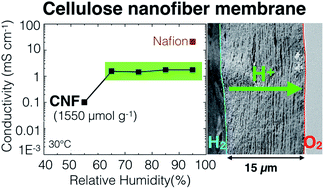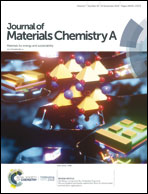Highly proton conductive membranes based on carboxylated cellulose nanofibres and their performance in proton exchange membrane fuel cells†
Abstract
The performance of thin carboxylated cellulose nanofiber-based (CNF) membranes as proton exchange membranes in fuel cells has been measured in situ as a function of CNF surface charge density (600 and 1550 μmol g−1), counterion (H+ or Na+), membrane thickness and fuel cell relative humidity (RH 55 to 95%). The structural evolution of the membranes as a function of RH, as measured by Small Angle X-ray Scattering, shows that water channels are formed only above 75% RH. The amount of absorbed water was shown to depend on the membrane surface charge and counter ions (H+ or Na+). The high affinity of CNF for water and the high aspect ratio of the nanofibers, together with a well-defined and homogenous membrane structure, ensures a proton conductivity exceeding 1 mS cm−1 at 30 °C between 65 and 95% RH. This is two orders of magnitude larger than previously reported values for cellulose materials and only one order of magnitude lower than Nafion 212. Moreover, the CNF membranes are characterized by a lower hydrogen crossover than Nafion, despite being ≈30% thinner. Thanks to their environmental compatibility and promising fuel cell performance the CNF membranes should be considered for new generation proton exchange membrane fuel cells.



 Please wait while we load your content...
Please wait while we load your content...